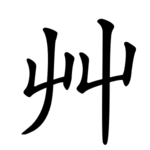| 艸 | ||
|---|---|---|
| ||
| 艸 (U+8278) "grass" | ||
| Pronunciations | ||
| Pinyin: | cǎo | |
| Bopomofo: | ㄘㄠˇ | |
| Gwoyeu Romatzyh: | tsao | |
| Wade–Giles: | tsʻao3 | |
| Cantonese Yale: | chóu | |
| Jyutping: | cou2 | |
| Japanese Kana: | ソウ sō (on'yomi) くさ kusa (kun'yomi) | |
| Sino-Korean: | 초 cho | |
| Hán-Việt: | thảo | |
| Names | ||
| Chinese name(s): | (艹) 草字頭/草字头 cǎozìtóu | |
| Japanese name(s): | 草/くさ kusa (艹) 草冠/くさかんむり kusakanmuri | |
| Hangul: | 풀 pul | |
| Stroke order animation | ||
 | ||
Radical 140 or radical grass (艸部) meaning 'grass' is one of 29 of the 214 Kangxi radicals that are composed of 6 strokes. It transforms into 艹 when appearing at the top of a character or component. In the Kangxi Dictionary and in modern standard Traditional Chinese as used in Taiwan, Hong Kong and Macau, 艹 (with two horizontal strokes) consists of four strokes, while in Simplified Chinese and modern Japanese, 艹 (with a continuous horizontal stroke) consists of three strokes.
In the Kangxi Dictionary there are 1902 characters (out of 40,000) found under this radical, making it the most commonly used radical.
艹, the upper component form of 艸, is the 30th indexing component in the Table of Indexing Chinese Character Components predominantly adopted by Simplified Chinese dictionaries published in mainland China, while 艸 is listed as its associated indexing component.